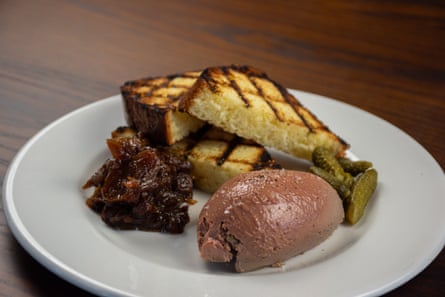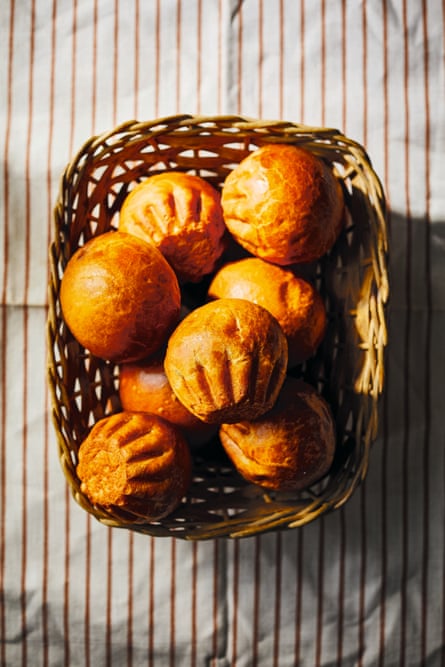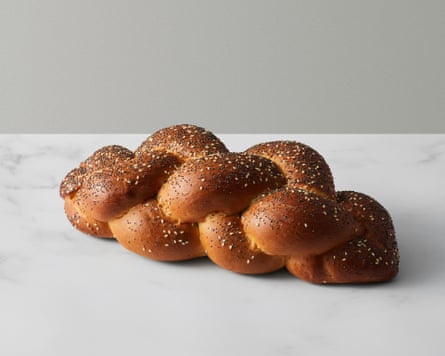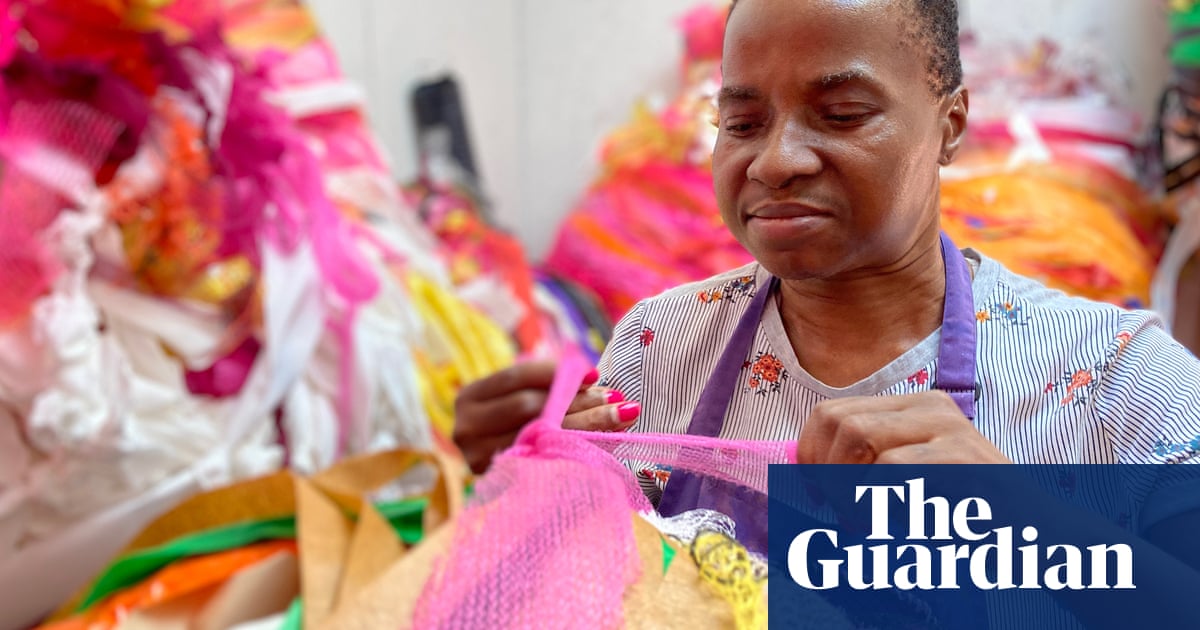‘You shouldn’t have to fight your sandwich,” says Sacha Yonan, his voice rising to compete with the noise of London’s Soho on a Tuesday morning. Within half an hour, queues for the sandwiches at Crunch, the cafe he co-founded earlier this year, will be snaking out of its doors. Its secret? Fresh brioche, which comes toasted and filled with ingredients that give the place its name, including southern-fried chicken, baby pickles and lettuce. “We love a sourdough,” says Joni Francisco, his Crunch co-founder. “But if you’re talking about sandwiches, then you need something with an easier mouthfeel.”
Could brioche be the new sourdough? Insofar as anything can be, sourdough being to bread what black is to fashion. In 2023, the humble white sliced loaf was hailed as a better sandwich bread than sourdough, the sourfaux scandal continues to rumble and, while we’re not baking sourdough at home with quite the same zeal as we were during lockdown, our lust for the real deal is still very much around.
What’s new is the popularity of brioche beyond burger buns, fuelled by bakers who have come to appreciate its versatility. “People in the UK understand brioche to mean any sweet, buttery white bread,” says baker James Morton, author of The Big Book of Bread: Recipes and Stories From Around the Globe. “But proper brioche has a long fermentation time, and a lot of good French butter whipped into the dough after it’s kneaded. It shouldn’t have lots of sugar; the sweetness should come from the butter and that long, slow fermentation, which gives it a more complex taste.”

Today, you’re as likely to find it in at lauded restaurants like London’s Sabor and The Shed in Swansea – plus cult bakeries like Edinburgh’s Krema and London’s Le Spot, a brioche-centric spot serving pulled oxtail brioche buns and brioche octopus hotdogs – as you are at Gail’s (where it’s blueberry-flavoured) or your average burger bar. “It’s buttery and springy and when you toast it you get those seared edges and slight bitterness from the toasting, which offsets heavier flavours,” says chef Jonathan Woolway of The Shed, of brioche’s appeal in more rarefied settings. He serves his with game liver parfait.
Inevitably, supermarkets have seen rising sales, too, though their brioches have none of the fine butter or long fermentation time that Morton mentions. Emilie Wolfman, trends manager at Waitrose, describes brioche as this summer’s “go to bread”, and the store sells own-brand burger and hotdog buns, and a brioche loaf.

As with many foods, its origin story is steeped in mystery. The Oxford Companion to Food says the word has been in use since the 15th century and derives from the verb “broyer” –to break up – which refers to the prolonged kneading process. It is an enriched bread, which means it contains fat (in this case butter and eggs) as well as bread’s standard trinity of flour, yeast and water. These luxury additions, along with the involved kneading process, meant that for centuries, brioche was a way flaunting wealth. “In the 17th and 18th centuries, these ingredients were expensive. Butter was more expensive than beef,” says Dr Neil Buttery, aptly named food historian and author of Knead to Know: A History of Baking. Brioche moved around the upper classes and royal courts of Europe, becoming “butterier, richer and eggier over the years”, he continues.
It’s what Marie Antoinette was supposedly referring to when she suggested the starving poor eat cake in place of bread: “Qu’ils mangent de la brioche.” Except Antoinette never actually said that. “The phrase derives from German folklore, long before the French Revolution,” Buttery says. Still, the Antoinette fable is a useful indication of brioche’s status. As with many things connected to class, “aspiration has since brought brioche down”, he says – but unlike chandeliers or designer handbags, connotations of luxury still linger. “You feel a bit richer when you eat a brioche,” says Benoit Blin, chef patissier at Le Manoir aux Quat’Saisons in Oxfordshire and a judge on Bake Off: The Professionals, who serves his with poached lobster.
In part this is because it’s French, and “we revere French food, and their attitudes toward it”, says Morton. Blin, who is French, puts this down to it seeming more artisanal than your average bun. “[One] associates burger buns with mass produced, highly processed food,” he says, so brioche buns became a way for classier burger joints to distinguish themselves. “It’s relatable, homely and reminds you of being a child,” says Crunch’s Yonan – almost irrespective of where you grew up.
Thanks to colonialism, globalisation and the agricultural revolution, which spread wheat to every corner of the globe, iterations of white enriched breads exist the world over. “Bakers are for the most part working with the same ingredients,” says Morton, whose Big Book of Bread boasts numerous variations. “So many breads are only mildly different – though with fierce defensiveness over them!” There is challah of the Jewish diaspora, babka of eastern Europe, concha of Mexico, pão doce of Portugal and milk breads of Britain and Japan. All are popular with everyone, but particularly children, being white, soft and slightly sweet thanks to that ‘enrichment’ of milk or butter. Brioche might feel like one of the most French foods imaginable, but you don’t have to be French for it to make you feel at home.

Like the crumpets of 2019, which appeared adorned with everything from braised mutton to lobster, it also taps into newstalgia: the neologism for our growing need, in unstable times, to experience the familiar bound up with the fresh. “Everyone knows they are supposed to be eating real, healthy, wholegrain sourdough,” says Jonny Lake, chef and co-owner of Trivet in Bermondsey, which serves a brioche bun with pickles and beef tongue. “But sometimes what you are looking for is toasted white bread.”
In short, post-pandemic, sourdough has become too ubiquitous to impress diners. “Everyone was baking sourdough when we were coming up with Crunch in 2021. We wanted to offer something different,” says Francisco. After months of experimentation, they developed a brioche made with a sourdough culture, to create a more structured bread that could hold sauce, and which people notice. “When people think of [us], they think of the bread first,” he says.
Brioche is not the new sourdough – and that’s a good thing, says Morton. Neither our environment nor our health can sustain eschewing regeneratively farmed wholegrain loaves in favour of refined white bread enriched with butter – not on a daily basis. But as a luxurious addition to our glorious gastronomic scene, it is as welcome as its warm, yielding dough is. “You don’t have to fight it,” Yonan says triumphantly. “For indulgence, brioche is king.”

.png) 3 hours ago
5
3 hours ago
5

















































